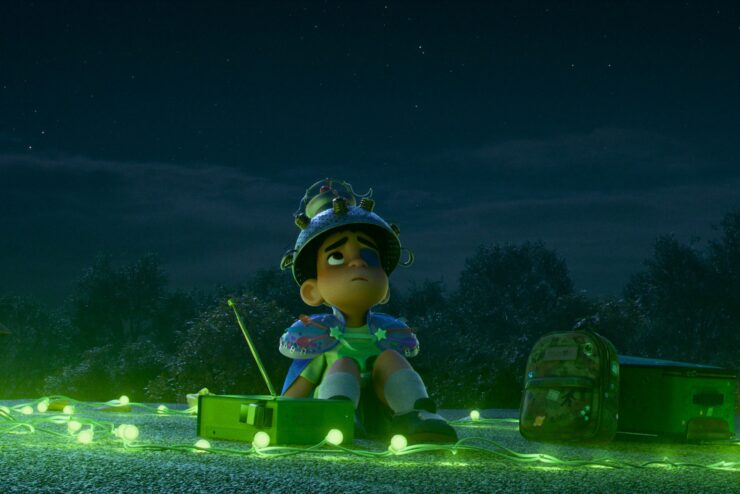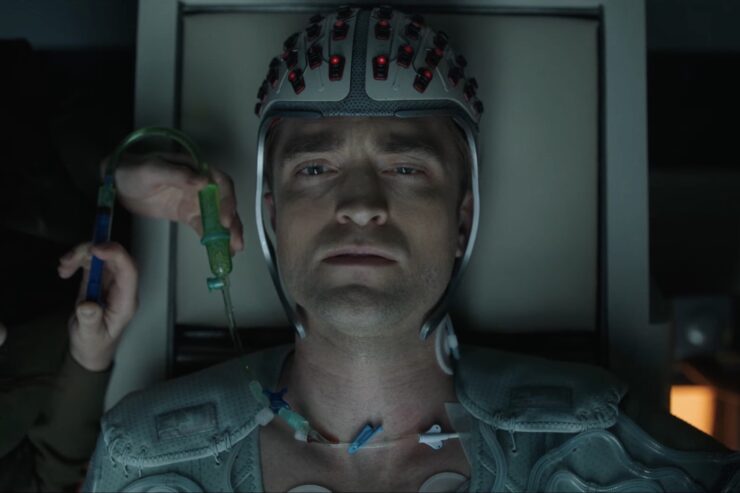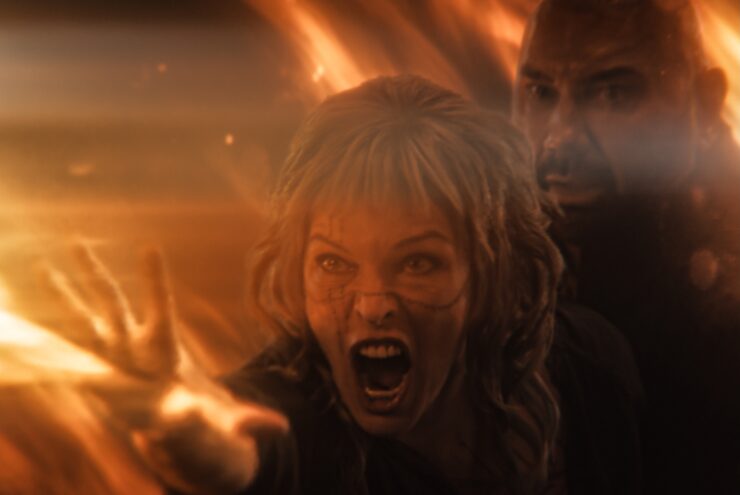There is a moment in Pan where Peter arrives in Neverland, and the audience discovers that it’s filled with miners—most of them children. They greet the new recruits from Peter’s orphanage with a cry of music, a boisterous rendition of Nirvana’s “Smells Like Teen Spirit.” Then Hugh Jackman’s Blackbeard arrives on the scene and joins in on the chorus, jumping up onto the rails of his pirate ship and throwing his arms open wide, like he wants to hug the world.
I really wish I had made all of that up.
Pan was not good. In fact, I can’t really call this a “review” because all I came away with was a headache, and a list of things that should never happen in the movie. If you’re not inclined to take my word for it, I can assure you that I was not the only one; practically everyone in my theatre shouted “What?!?” incredulously at several points during the film. No one was happy. I think the only reason people stayed through the whole screening was because it was raining pretty hard outside and we all wanted to see if we could outlast the storm.
This film pretty much proves everything that’s wrong with the Hollywood machine these days. We’ll forgive a misstep or two from films that we’re already excited for, but making all of those missteps in a single film that no one was really hankering for is pure negligence. So what should today’s blockbusters be avoiding? Here’s a handy list:
Spoilers for the whole film below.
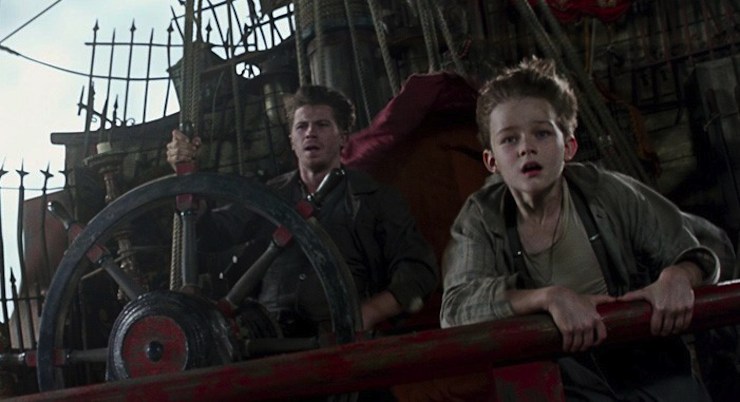
1. Never Showing Your Work
You know that annoying thing that math and science teachers make you do, where you have to prove that you understand how you got from Point A to Point B by writing down the steps to get there? Remember how it sucks, but it’s also kind of really important?
Yeah, that rule applies to filmmaking most of the time, too.
Pan is one long series of jump cuts. As in, there are countless scenes where characters say “Let’s do a thing!”—and then you cut to the next scene, and that thing they were talking about doing has already been done. So Hook says “We’re gonna fix this busted-up pirate ship so it can fly!” Then we cut to the next scene, and the ship is repaired and flying. Do this a couple of times in a film, and the audience can forgive it. Do this in practically every scene, and you’re proving one of three things:
A) Your film has too much packed into it, forcing you to cut large, bleeding chunks out of your story so it fits into the two hour limit.
B) Your film is relentlessly boring, and erasing huge portions of the action was the only way to make it watchable.
C) You can’t figure out how to make everything in your film happen, so jumping away from the story at key moments prevents you from having to think about how your world works.
In the case of Pan, it was a little of all of these; I mean, it would have been pretty cool to find out how Hook and Peter repaired the flying pirate ship, right? But it wasn’t a priority because too many other things had to happen in the story. It’s not the only transport that suddenly appears as needed—Peter, Tiger Lily, and Hook find a strange boat at some point, but we’re never around for its discovery. We just cut to our heroes on the water, and are forced to accept this timely acquisition.
Then there’s the purpose of Neverland’s mining operation; to obtain “pixum,” or fairy dust, which Blackbeard is using to stay young. We find that out that it’s an immortality agent because the film arrives at a scene featuring an old man mixing up the pixum and turning back into Blackbeard. We never see him age into the old man at any point beforehand, though. He’s suddenly ancient, and then he’s Hugh Jackman again.
This is a family film, so death is handled in an off-putting way, too; the pirates are allowed to die horribly—like normal folk—but the Natives of Neverland literally explode into puffs of brightly-colored dust. No rhyme or reason for that one—it just looks whimsical, the way death should be (?!??!)
The aforementioned Nirvana segue is another place where “showing your work” should have been in play. (And it’s not the only offense—there’s a Ramones song in there, too.) After the musical interlude, Blackbeard gives a throwaway line about how the kids in Neverland come from across time, giving an explanation as to how ye olde pirates might know what Kurt Cobain rocked out to. But this is never brought up again because its only purpose in the script is to justify the use of modern music. Which then only serves to prove how out of place it is. (FYI, the reason that music was actually chosen was because all the fellows in “pirate bootcamp” for the movie weren’t feeling the traditional sea shanties, so director Joe Wright brought in some current music for funsies. Because that’s how you make important world-building decisions.)
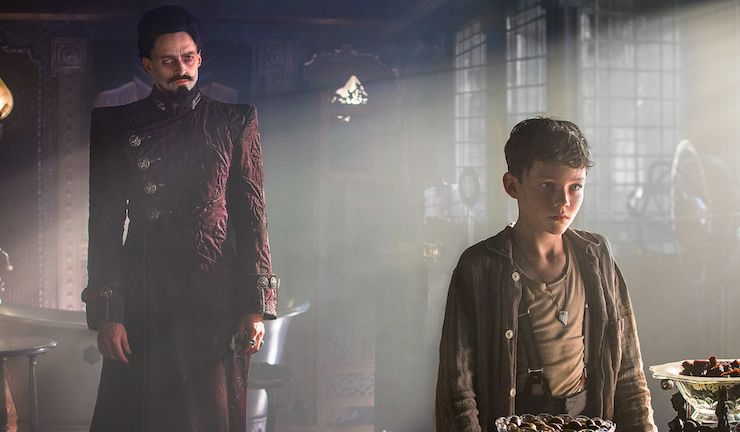
2. Plots Full o’Clichés
Look, movies (especially big crowd-pleasing ones) have a flow to them. They all play into certain clichés, and that’s okay, since we’re often just looking for something diverting and fun. But if your entire movie is built on them and has nothing original to recommend it? At that point, it’s time to go back to the board and find a story you’d really enjoy telling.
And no, “re-imginaging” the Peter Pan story does not give you points for originality—especially if you do it badly (which I’ll get into later).
Pan is a movie that took stock lines from every other movie and slotted them in wherever explanations were needed. When Levi Miller’s Peter meets Garrett Hedlund’s Hook, he learns that they’re both miners that have been forced into Blackbeard’s service—but Hook is the veteran. Hook decides to help Peter, sharpening his ax so the kid’s instrument doesn’t tear up his hands so badly. But then, to prove that he’s our rugged antihero, he says, “I’m not your friend, kid.” Get it? Because he’s going to prove that he’s Peter’s friend later, and then we’ll all give a hearty laugh about how cold he tried to be in the beginning!
In perfect cliché form, once Peter accidentally flies for the first time in front of Blackbeard, the pirate takes him aside to tell him of a prophecy—one that speaks of a Neverland “native” and a fairy prince who had a child. A child that was destined to destroy the pirate king. You may have seen the trailer, where Blackbeard asks Peter “Are you here to kill me?” and the kid’s response is “I don’t believe in bedtime stories.” And sure, he’s scared, but I’m still expecting him to throw on a pair of aviator shades and stalk out.
Peter has to wrestle with his destiny, of course, but 90 minutes into the film he’s still not feeling it. He tells Tiger Lily that he’s scared about trying to fulfill said prophecy and failing to be the “Pan” everyone thinks he is, and she bravely tells him, “What if you fail to try?” because that’s a very convincing argument to get someone to accept responsibility for an entire world. Since it’s fine if you completely ruin everything as long as you gave it the old college heave-ho! Er….
It gets even worse when you count the sequel set-up that they voiceover-in at the end: Pan and Hook have a happy moment, which Peter busts up by thinking about what could possibly ruin their newfound friendship. Then Hook is like, I know, right? What could possibly come between us at this point?
Groan.
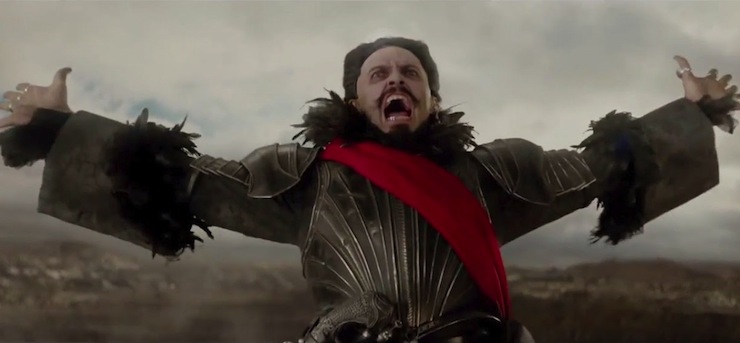
3. Genre-Mashing for No Reason
The Nirvana-time music kerfuffle lends Pan a strange (and ultimately brief) Baz Luhrmann-y sheen, which would have been a fine direction if the film had actually stuck to it. But there are about seven different movies stuffed into Pan, all the result of brief flirtations with various archetypes and action sequences. When the film begins, Peter is kidnapped out of an orphanage by Blackbeard’s ship… but this is during World War II, during the air raids, and a sea of British fighter planes are called forth to combat the strange ship in the sky.
So we’ve got half of a war movie, like the start of The Lion, the Witch, and the Wardrobe, but without any of the substance. (When the planes approach the rigging, Peter actually shouts “Oh, come on!“—clearly as incredulous as we are.)
Then we meet Garrett Hedlund’s Hook, who has a very strange mush of an accent, as though Jimmy Stewart and Karl-Urban-as-Dr-McCoy taught him how to cowboy together, in a moment of unforeseen brotherhood. Peter, Hook, and Smee’s escape from the mines smacks of an old-fashioned western, as does their initial encounter with the Natives of Neverland, who hang Hook upside-down by his ankles.
We’ve got their encounter with the giant Never-birds, which has a hint of Wonderland about it, but Peter’s use of the beasts to rescue his friends is straight out of Avatar, and every other movie ever like it.
The heroes eventually find the lost fairy kingdom (hidden away all this time in another dimension to prevent Blackbeard from getting his hands on their pixum), and when Peter decides to accept his destiny, the fairies rally to him… but they don’t behave like an army. They behave like a superpower. Peter controls the lot of them through hand gestures and posing, and they charge at things like a single beam of fairy light. Peter seems more like Iron Man that the Boy Who Won’t Grow Up.
Some genre-hopping in a movie can be incredibly effective. People love mashups. On the other hand, Cowboys and Aliens failed to be effective for a reason, and having this many genres piled into one movie is plain sloppy. Deciding to create a Pan musical with pop songs would have probably served them better in the end.

4. Fake-Out Diversity
If you paid attention to the casting announcements for Pan, you heard about the controversy surrounding Rooney Mara’s casting as Tiger Lily. Director Joe Wright claimed that he intended to create a diverse Neverland from the beginning, and Lupita Nyong’o and Pooja Hegde were both considered for the role. Javier Bardem was also offered the role of Blackbeard before Hugh Jackman took it on. The denizens of Blackbeard’s mines and the Natives of Neverland are an entirely diverse population, and that’s only right; if Steven Spielberg had the good sense to cast a non-homogenous group of Lost Boys twenty years ago in Hook, then it would have been a serious mistake not to attempt the same in 2015.
And yet all the lead characters in Pan are white.
It’s a glaring misfire, and one that was pointed out from the beginning. If anything, the seas of POC extras in the film only make the problem more pronounced; the Natives of Neverland are a diverse group that are ultimately led by a white woman. Blackbeard is white, Peter is white, Hook is white. If Neverland is meant to be diverse, then all of these characters needed to be as well. (Smee is the only notable exception, but he’s the group “traitor”… so we get another layer of wince on our awkward sandwich.) Indeed, given how heavily the world of J.M. Barrie’s Peter Pan has been revamped, there’s no need for anyone to be English or white at all.
The movie manages to do even poorer still where women are concerned. Peter finds out that his mother (Amanda Seyfried) was a Neverland Native, and that his father was a fairy prince who became human for one day to be with the woman he loved. After his father’s death (because fairies can only last a day in human form), Peter’s mother hid him on Earth, where he was to remain until he was ready to come home and fulfill his destiny. She fought for her people and the fairies against Blackbeard, who was in love with her and ultimately killed her. Peter finds out that his mother was a warrior, and that’s meant to be inspiring to him. But she’s ultimately another woman in a refrigerator; strong, but still dead because the plot requires that Peter look to her for inspiration, not for him to find a mother.
We find out that Tiger Lily learned to fight from Peter’s mom, and she proves her warrior’s mettle throughout the film, only to need rescuing by Peter in the final act when she goes up against Blackbeard. So after two hour’s worth of talk about important warrior women who get the job done, all the women in the narrative are still sidelined or dead so that we can be reminded of our sacred hero’s birthright. Tiger Lily’s romance with Hook is sad and undeveloped. He’s supposed to seem charming, but he does practically nothing to recommend himself as a companion other than show up at the last minute to help. (Sure, Han Solo did that too, but Leia made him work for it over the next few years.)
And then there are the mermaids, who are identical clones of Cara Delevingne… which comes off less like a creative species choice, and more like a weird naughty dream that the screenwriter had one evening that no one ever needed to know about.
These days, audiences are quick to suss out when you truly care about diverse perspectives, and when you’re going through the motions. Pan fails even the most preliminary tests in that regard. Sure, the filmmakers were probably worried about offending moviegoers by sticking with the Native Indians of Neverland (since no version of the Peter Pan story has ever been particularly stellar in depicting Native Americans), but better to do that and fail than never even try in the first place.
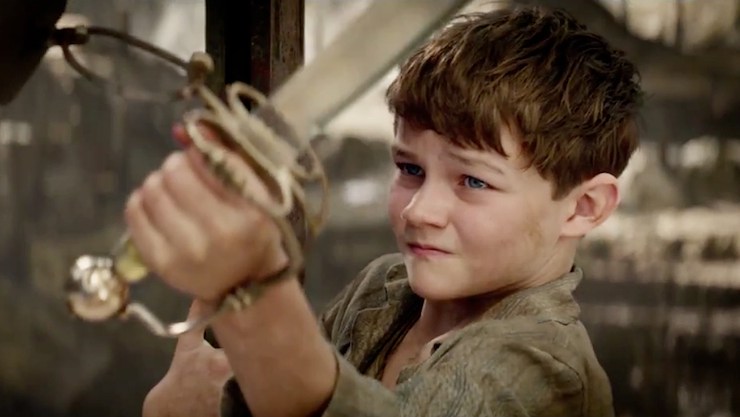
5. Utter Disregard for the Source Material
This is the one that sticks the hardest for me. Because whatever flaws it may have, I adore Peter Pan. It’s a story that is dear to my heart, and there are key tenets that should be observed for any successful adaptation. So what did this movie really get wrong?
It’s a mythic origin story.
Peter Pan is not a Hercules. He not a Gilgamesh or a Beowulf or an Achilles. Peter Pan is not a stock hero with a great destiny—he is a god of mischief. He is fickle and cruel. He is boisterous and haughty. He is kind only when the mood hits him. Of all the characters who deserve an epic for an origin story, Peter Pan has never been one of them. Giving him this grand background as a sacred son of Neverland, the child of a native woman and a fairy prince, it speaks of a fundamental misunderstanding of what Peter Pan is and what he is meant to embody. (No, seriously, I wrote an entire article about this a year ago.)
Many reviewers have hopefully labelled this film as the death of the “origin story” plot, and certainly it’s one that Hollywood has done to death. But giving Peter Pan an origin story isn’t necessarily a mistake—the mistake is in giving him the same origin story as everyone else.
Fine, anything can be re-imagined any way you want, but that doesn’t mean it should be. And ultimately you have a responsibility to understand the story you adapt. And Peter Pan is a fascinating children’s tale for the precise reason that Peter isn’t essentially “good.” It’s not anyone’s job to make him more palatable when he’s captivating exactly as he is. Scrubbing him clean and turning him into a wonder boy robs us of a complex figure who gives us a window into the uglier aspects of childhood. Jealousy, greed, limited attention span, inability to empathize, these are all hallmarks of Pan. Let him be the horrible, wonderful boy he perceives himself to be.
But perhaps most important of all, this version of Neverland has destroyed an essential aspect of Barrie’s legacy: imagination. Neverland is not a solid place that can be measured with dimensions and periodic tables and mile markers. It is a place of pretend, its boundaries are permeable, its reality always in question. To give this world rules, chemical substances, hierarchies of people, makes it antithetical to everything that Neverland stands for.
Neverland is meant to be whatever you see when you close your eyes.
The general consensus seems to be that people don’t like Pan, and that’s at least a relief. But Hollywood keeps making movies like it and assuming that we’re eager for more. So maybe they should implement a checklist? A set of guidelines? At the very least, they could make an effort to avoid these obvious missteps.
And then I’ll never have to sit through another Pan again.
Emmet Asher-Perrin feels particularly bad for Levi Miller, who did a lovely job through the whole thing and deserved a better movie to star in. You can bug her on Twitter and Tumblr, and read more of her work here and elsewhere.











